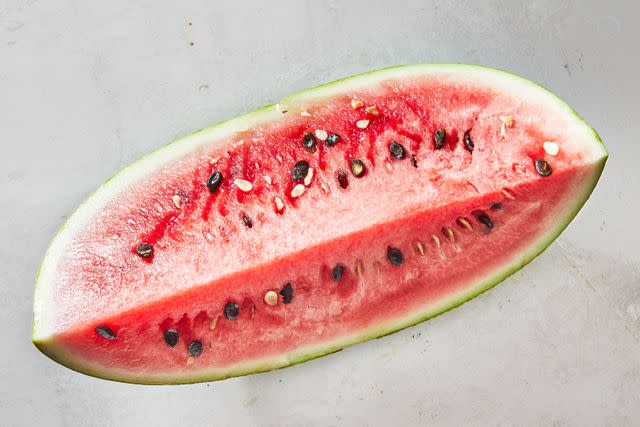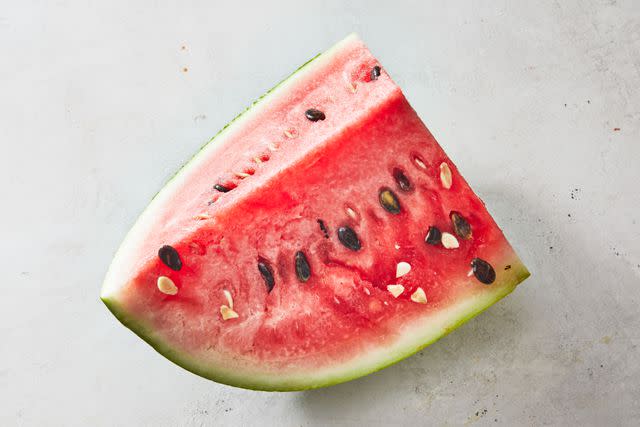Can You Eat Watermelon Seeds?
These versatile seeds are more beneficial than you might think.
Fact checked by Khara Scheppmann
As a child, you may have found yourself on the receiving end of an old wives’ tale warning that if you swallow watermelon seeds, you’ll end up growing a melon in your stomach. No doubt a few seeds have accidentally slipped down your esophagus over the past few decades, but hopefully you aren’t still waiting for your internal watermelon patch to grow. The truth is, that watermelon seeds are perfectly fine to eat.
“One hundred percent of the watermelon is usable,” confirms Stephanie Barlow, Senior Director of Communications at the National Watermelon Promotion Board (NWPB). In fact, you may want to intentionally start eating more of them once you learn about their nutritional benefits and a couple delicious ways to prepare them.
Meet the Experts
Stephanie Barlow, Senior Director of Communications at the National Watermelon Promotion Board (NWPB)
Lauren Manaker, MS, RDN, LD, CLEC

Caitlin Bensel; Food Stylist: Torie Cox
Watermelon Seeds Benefits
Watermelon is a nutrient-dense fruit with various minerals, fiber, and phytonutrients. It is an excellent source of vitamin C, a good source of vitamin A, vitamin B6, and potassium.
“Watermelon seeds are a natural source of manganese, phosphorus, potassium, protein, folate, essential fatty acids, iron, and zinc,” says registered dietitian Lauren Manaker, MS, RDN, LD, CLEC. “These different nutrients, like manganese, help proper brain and nervous system functioning, while phosphorus aids in healthy bone formation. Iron aids in fighting against iron deficiency, which in turn improves focus and energy levels.”
They are also an unexpected way to get some more protein into your diet. Barlow says there are 10 grams of protein in one ounce of sprouted, shelled, and dried watermelon seeds. Additionally, they are low in calories — an ounce contains 158, and an ounce is a lot of seeds.
Types of Watermelon Seeds
There are two main types of watermelon seeds — black and white — and you can eat both. Black seeds are full, mature watermelon seeds, explains Manaker. You can take these seeds and plant them in the ground to produce more watermelons.
The white seeds are just the hollow shells of black seeds that didn’t mature. “These are much easier to swallow because of their soft fleshiness, and you find much more white seeds in seedless watermelon, as the watermelon is specifically bred to not produce mature seeds,” says Manaker.
According to the NWPB, the majority of watermelon production is seedless in the U.S. due to demand. “This variety is a result of hybridization, which is the crossing of two different types of watermelon,” explains Barlow. Contrary to popular belief, the process does not involve genetic modification.

Caitlin Bensel; Food Stylist: Torie Cox
How To Eat Watermelon Seeds
Aside from just chewing and swallowing the seeds as you enjoy a juicy slice of watermelon, there are also a few tasty ways to prepare them — namely, roasting and sprouting.
Roasted Watermelon Seeds
Plenty of people will argue that the absolute best way to eat watermelon seeds is after roasting them — it’s a great crunchy snack or topping, akin to eating roasted pumpkin seeds. To make them, Manaker says to start with a seeded variety of watermelon, of course, and then follow this recipe:
Preheat your oven to 325ºF.
Remove the black seeds only from the watermelon. Place the seeds into a fine colander and rinse thoroughly.
Strain the seeds and pat them dry with a towel. Then spread the seeds out as much as possible, so there’s plenty of airflow around them, and wait for them to dry completely (speed this process up by placing them outside in the sun). Dry seeds roast up much better than damp ones.
Place dried seeds on a cookie sheet, spray with oil, and bake for 15 to 20 minutes. Sprinkle salt on top once removed from the oven, if desired.
Sprouted Watermelon Seeds
Sprouted watermelon seeds — a process where fresh seeds soak and then naturally shed their black shells — are growing in popularity.
To sprout your watermelon seeds, Barlow suggests simply adding them to water, letting them soak for a few days, and allowing them to “do their thing.” Once they have sprouted, rinse them off, allow them to dry completely (which will help them last longer), and enjoy as a crunchy addition on top of salads or cereal.
Related: 28 Watermelon Recipes To Serve This Summer
For more Southern Living news, make sure to sign up for our newsletter!
Read the original article on Southern Living.

